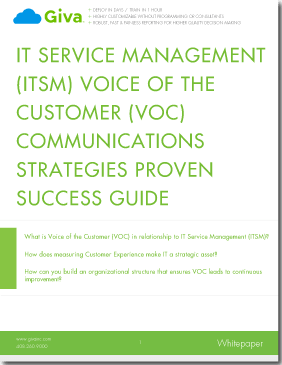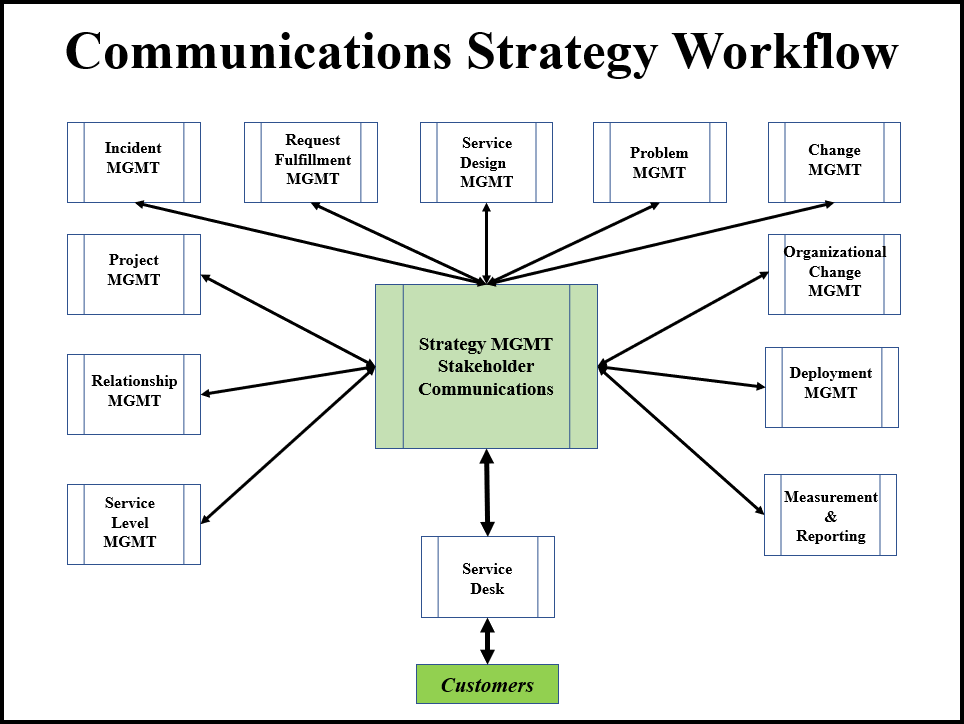IT Service Management (ITSM) Voice of the Customer (VOC) Communications Strategies Proven Success Guide

Learn about these proven communications strategies:
What is Voice of the Customer (VOC) in relationship to IT Service Management (ITSM)?
How does measuring Customer Experience make IT a strategic asset?
How can you build an organizational structure that ensures VOC leads to continuous improvement?
Introduction
The purpose of this whitepaper is to provide new ideas for optimizing communications between Information Technology (IT) and its "stakeholders", or in other words, understanding the importance and relationship in IT Service Management (ITSM) between IT and the Voice of the Customer (VOC).
To begin, who are IT's Customers? They are "stakeholders", which is anyone that might have an interest or involvement in what IT is doing. Stakeholders could be:
- Customers
- Users
- Sponsors
- Suppliers
- Other IT departments
- ...in actuality, anybody!
The Voice of the Customer Program in ITSM
The best information you will ever receive is stakeholder feedback. It quite literally takes the guesswork out of running IT like a business. If it is good for an area of service, keep doing it. If it is not so good, improve it.
"Feedback — The Breakfast of Champions,"
Ken Blanchard, author, One Minute Manager
Ken Blanchard, author, One Minute Manager
If your goal is to get better, if you want your IT department to be a strategic asset for your company, you should embrace the concept of "Continuous Improvement". There is no better way to improve than to ask your customers what they require for their success.
To ensure IT has a continuous flow of feedback in voice of the customer initiatives, best practice suggests that IT have a communication strategy and have plans in place to provide alignment between IT and its customers.
What is the difference between a "strategy" and a "plan"?
"Strategy" is high-level thinking. Ideas about how IT communications will go from where you are now to where you want to be. An example might be:
"A holistic IT planning approach for customers to ensure greater effectiveness of our services."
A "Plan" is about the specifics and has a definite purpose. Everyone must follow plans, with no deviations. Follow the plan, achieve the goal. An example of this might be:
"All incoming customer communications for services must go through the Service Desk as the Single Point of Contact (SPOC). If anyone in IT other than the Service Desk receives an unsolicited customer request for service, gently redirect the customer to the Service Desk at extension 1234. All service level agreements (SLA) specifically point out this requirement. No exceptions!"
Customer Experience: The New Metric for IT to Consider on the Road to Becoming a Strategic Asset
IT Service Management (ITSM), the world standard for running IT like a business, says, "An important element of value is the experience your service consumers have when they interact with the service and service provider (i.e., IT).1 This is often called "Customer Experience" (CX) or "User Experience" (UX) and is an important part of the voice of the customer methodology. While those terms are often associated with customer service or application development, they can also apply to ITSM. A great customer experience requires a customer-centric mindset.
CX is the result of every interaction a customer has with IT:
- Interacting with your IT web site
- When a service desk agent answers the phone
- Receiving an email telling them about their ticket submission
- The service desk agent's knowledge
- Accurate priority setting (e.g., impact + urgency)
- The ability to resolve issues without escalation
- Escalation experience to level 2 or 3, (e.g., is it timely, do they know your history, so you do not have to repeat it?)
- Listening skills of everyone on the case
- Empathy
- Quality of tools provided to customers (e.g., ease of use, warranty, mean time to failure)
- Self-help tools
- Knowledge articles
- Asking for customer feedback to develop an in-depth understanding of your customers
- IT urgency for eliminating repeat incidents that interfere with productivity and revenue
- Joint efforts to improve user productivity
- Understanding notifications and communique from IT
How to Build an IT Organizational Structure that Ensures Listening to Voice of the Customer Feedback Leads to Continuous Improvement in Support of Your Vision

Figure 1: ITIL Practices Supporting Communications Strategy
This workflow diagram shows the key ITIL practices that support the communication's strategy in a voice of the customer program. In the center is the "Strategy Management" practice. The practice mission is to "formulate the goals of the organization and adopting the best courses of action and allocation of resources necessary for achieving those goals."2 Communications is one of many strategies supervised by this essential practice.
When dealing with all the different stakeholders, strategy wants to create a clear and concise IT message used consistently over every interaction. The goal is to present the best face and build stakeholder confidence that the IT department is their business partner, and they are going to help the business achieve its goals.
In addition to the focus on the outflow of consistent quality information, is the gathering of feedback to meet the objective of continuous improvement. There is, obviously, a strong relationship. To improve the outflow, the strategy focuses on what the customer experience is (e.g., improve one, improve the other).
Strategy management is the practice in the center. Its role is to analyze stakeholder interactions for opportunities from all over the business to increase feedback. Then Strategy communicates to all practices and departments what the most successful interactions are. The Strategy practice works closely with other practices that have the most interaction opportunities, those displayed in the diagram. But all practices interact with the business and other IT groups and practices, which can improve communications as part of continuous improvement.
Looking deeper into the workflow diagram, we see the double-headed arrows. For example, "Incident MGMT" supplies feedback to "Strategy MGMT" of its successes and its challenges. The Strategy practice works with "Incident MGMT" to develop better ways to align with the overall strategy for greater success. The result is increased customer satisfaction through the customer experience.
ITIL states "the purpose of the service desk practice is to capture demand for incident resolution and service requests. It should also be the entry point and single point of contact for the service provider with all of its users".3
In keeping with the ITIL best practice that the Service Desk is the primary communication point between IT and the stakeholders, the diagram shows a heavy arrow between "Strategy MGMT" and "Service Desk", and between "Service Desk" and "Customers". If, for example, "Change MGMT" wants to communicate something about weekend changes, they should:
- Use Strategy guidance on how to create the information document, (e.g. a template provided by Strategy)
- Supply what they want to say to the Service Desk
- The Service Desk wordsmiths it and sends it out as the official "Voice of IT"
This best practice brings efficiency and consistency:
- It takes the burden off the other practices
- The Service Desk keeps up on IT communications to users/customers
- They can write it in a way that the audience understands
When you think about it, this makes sense. If the communication is not clear, and if it does not get to the right stakeholders, then it will be the Service Desk phones that will ring off the hook. And then what happens to CX?...it plummets very quickly.
Communications Excellence Requires Knowing Your Stakeholders
Besides the day-to-day continuous information delivery, communications strategy encourages other actions to increase customer trust and feedback, such as organizational/staff/executive staff meetings, voice of the customer surveys, etc. Keep a "Continuous Improvement Register" (CIR) which notes all information gathered.
The following are some examples:
- Conduct quarterly brown bag lunches with the company's administrative assistants. Besides the opportunity to put faces to names, gathering valuable information about what a hard job they have leads to cooperation on new ways of interacting to make the admin assistant's job easier. Further, they work closely with business executives, and you can find out how to better approach the executives and what they need for their success.
- Add to Service Desk agent job requirements that when they are not on phone duty, they call one customer in the morning and one in the afternoon. They follow a script of open-ended voice of the customer questions about the service from their last interaction. Learn from the customer's perspective on how IT can do better. Log lessons learned.
Moments of Truth4
15 seconds. That is how long it takes for someone to form an opinion of you and your service. The concept means that throughout the day there are many IT/stakeholder interactions where IT staff, web pages, reports, or other interactions with stakeholders shape their impression of IT. How well your organization manages these "moments of truth" determines whether IT succeeds or fails as a critical business partner.
Having a communications strategy in any voice of the customer program is all about how to manage the moments of truth. Some benefits are:
- It forms a better partnership with stakeholders
- It helps them to succeed
- It gathers valuable information on how IT can perform better
Conclusion
Do not be an abyss of lost opportunities in your company. Your IT department has so many possibilities to communicate IT successes. One of the most effective is a monthly/quarterly IT performance newsletter. The newsletter shares stories about customer satisfaction, continuous improvement, customer experiences all in the voice of the CIO and VOC. It is not about how great IT is.
An example of stories to share:
Each IT department and practice collaborate with their stakeholders and gather business success stories. The stories flow to a single point (you choose) for consolidation into an "IT's Working for You" newsletter. This is just one more tool in your VOC tool kit.
How to improve?
Ask your stakeholders.
Deliver.
Footnotes:
1. Axelos, ITIL Foundation ITIL 4 Edition, 2019, section 4.3.1.3, p. 43
2. Ibid. p. 103
3. Ibid, p. 149
4. Moments of Truth, Carlzon, Jan, 1987